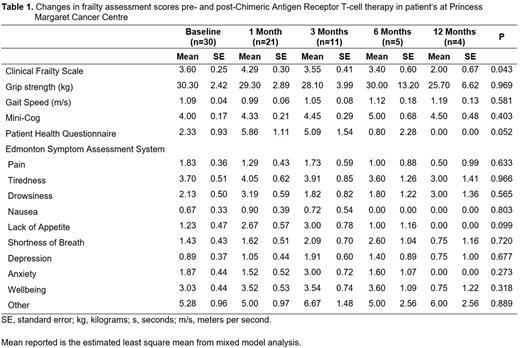Abstract
Introduction
Princess Margaret Cancer Centre is 1 of 3 adult centres in Ontario, Canada providing Chimeric Antigen Receptor T-Cell (CAR T) therapy as a standard of care treatment for patients with relapsed and refractory B-cell lymphoma, with the first patient treated in June 2020. There is no upper age limit for treatment referral, and frailty is an important consideration in assessing fitness for treatment. However, there is limited published research in this area. One study found that fit patients had improved response rates, progression-free survival (PFS), and overall survival (OS), than patients who were unfit/frail (Zhang. Leuk Lymph. 2022). This data supports the need for further characterization of frailty in patients undergoing CAR-T. This study aims to determine if frailty assessments pre-CAR T can predict those at higher risk for acute toxicities, PFS, and OS. Additionally, changes in frailty in the 12 months following treatment compared to baseline will be described. Understanding how CAR T therapy affects a patient's frailty over time will facilitate planning appropriate interventions.
Methods
We performed a cohort study of consecutive patients with lymphoma undergoing CAR T-cell therapy at our institution, from April 2021 to present. Information regarding clinical presentation, histological subtype, prognostic factors, bridging treatment, and acute toxicity, such immune effector cell-associated neurotoxicity syndrome (ICANS) and CRS, were collected. Frailty was evaluated using the Clinical Frailty Scale (CFS), Grip Strength, Gait Speed, Mini-Cog, Edmonton Symptom Assessment System (ESAS) and Patient Health Questionnaire (PHQ-2 and PHQ-9) at 5 time points: baseline (clearance visit), and 1, 3, 6 and 12 months post-CAR T. We discontinued assessments upon progression. At baseline, additional assessments were completed to further characterize frailty including the Vulnerable Elders Survey (VES-13), Hematopoietic Cell Transplantation-specific Comorbidity Index (HCT-CI) and Cumulative Illness Rating Scale (CIRS).
Results
Thirty patients have been enrolled to date. Mean age was 59 ± 13.5 years and patients were primarily male (58.6%). All 30 patients were diagnosed with non-Hodgkin lymphoma; 46.4% had de novo diffuse large B-cell lymphoma, and 21% had transformation from follicular lymphoma. Median follow-up is 2.9 months (Q1 1.2, Q3 9.4). All 30 patients completed assessments at baseline, 21 completed 1 month, 11 completed 3 month, 5 completed 6 month, and 4 completed 12 month assessments. Median scores on the HCT-CI, CIRS and VES-13 at baseline were 1.0 (Q1 0.0, Q3 3.0), 2.0 (Q1 1.0, Q3 6.0) and 1.0 (Q1 0.0, Q3 5.0), respectively. There were clinically significant changes observed in CFS over time (p=0.043), with mean scores of 3.60 (0.25) at baseline and 2.00 (0.67) at 12 months (Table 1). There were no significant changes (p=0.969; p=0.582) between timepoints for either of the physical assessments of grip strength or gait speed. Compared to other assessments, PHQ total score had a larger difference between timepoints with mean scores of 2.33 (0.93) at baseline and 0.00 (0.00) at 12 months, however, this was not significant (p=0.052), likely related to limited sample size (N=4).
When analyzing specific acute toxicities, 7 patients experienced ICANS (Grade 3 7.1%, Grade 2 3.6%, Grade 1 (14.3%)). Twenty-five patients (89.3%) experienced CRS (Grade 2 50.0%, Grade 1 39.3%) during the 30 days following cell re-infusion.
There have been 8 progression events (2 patients with progression remain alive), and 7 deaths with 1 occurring without disease progression. There was a 76.9% probability of PFS at 3 months and 64.5% at 6 months, with 3 month and 6 month OS 80.2% and 74.5%.
Conclusions
The only repeated measurement of frailty that found to have clinically significant changes between timepoints was the CFS, suggesting an element of reversible functional impairment related to patients’ lymphoma. Overall patients appear to be impaired at baseline, worsen through the first 1-3 months, and improve by 12 month if in remission. However, the number of patients who completed the 12 month visit to date is small and more data is needed from ongoing follow-up and accrual.
Disclosures
Prica:Kite-Gilead: Honoraria; Astra-Zeneca: Honoraria. Chen:Gilead: Consultancy, Honoraria, Research Funding; BMS: Consultancy, Honoraria; Novartis: Consultancy; Abbvie: Consultancy; Beigene: Consultancy. Kuruvilla:Abbvie: Consultancy, Honoraria; Bristol Myers Squibb: Consultancy, Honoraria; Gilead: Consultancy, Honoraria; Karyopharm: Consultancy, Honoraria, Other: DSMB; Merck: Consultancy, Honoraria, Research Funding; Roche: Consultancy, Honoraria, Research Funding; Astra Zeneca: Honoraria, Research Funding; Amgen: Honoraria; Janssen: Honoraria; Novartis: Honoraria; Antengene: Consultancy; Medison Ventures: Consultancy; Seattle Genetics: Consultancy, Honoraria; Inctye: Honoraria; Pfizer: Honoraria; Lymphoma Canada: Membership on an entity's Board of Directors or advisory committees. Crump:Kyte/Gilead: Honoraria; Novartis: Honoraria; Roche: Research Funding. Kridel:Abbvie: Research Funding. Kukreti:Kwoya Kirin: Honoraria; EUSA Pharma: Honoraria.
Author notes
Asterisk with author names denotes non-ASH members.


This feature is available to Subscribers Only
Sign In or Create an Account Close Modal